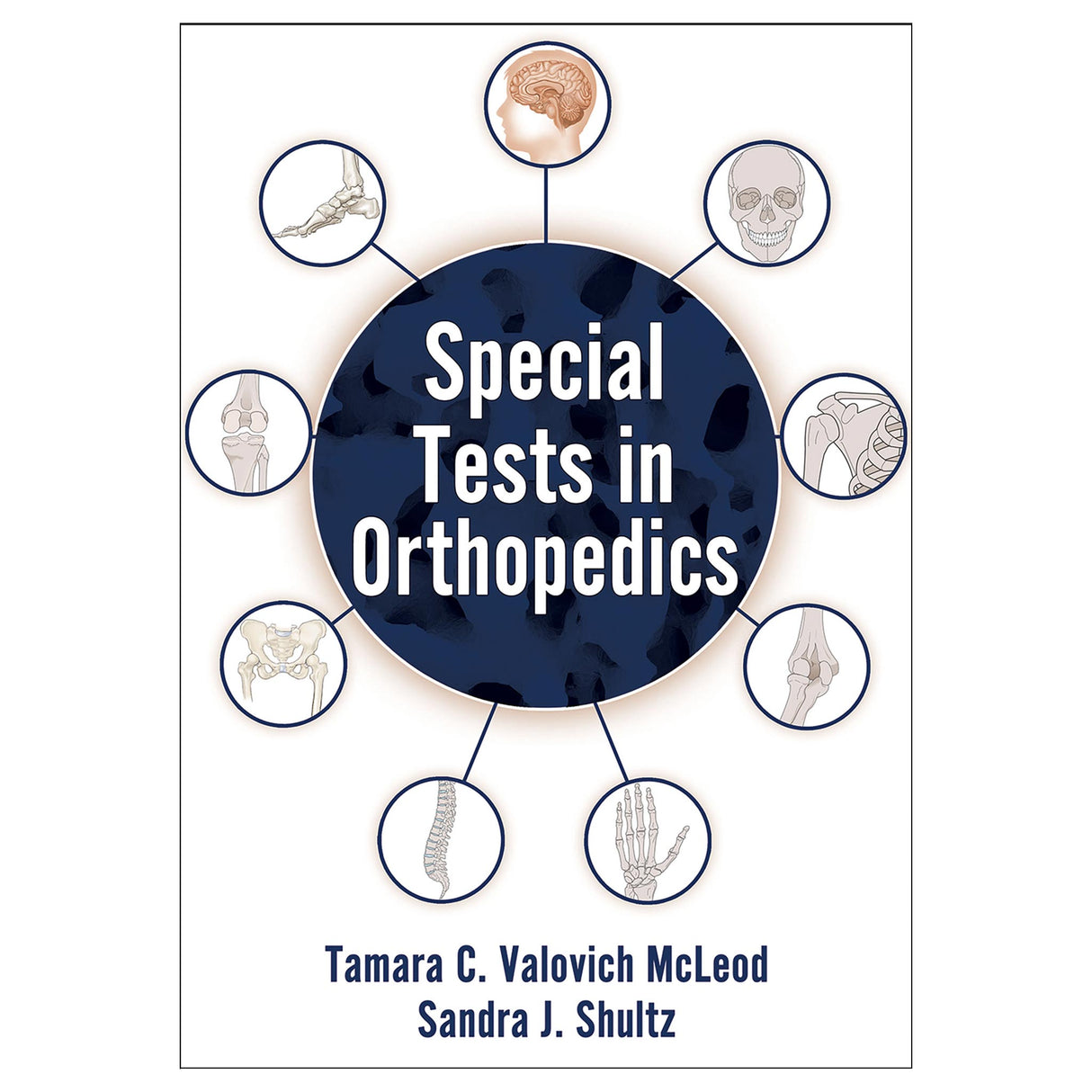Special Tests in Orthopedics
$49.00 USD
Easily reference orthopedic special tests, organized by body region.
Clinicians employ many tools to help them accurately diagnose and rehabilitate orthopedic injuries. Special Tests in Orthopedics serves as a quick way for professionals and students to reference 214 different special tests organized by body region and diagnosis.
Each case is unique, and it’s important to know which tests should be used to positively identify a diagnosis. That’s why each test in this book features the psychometric properties for each assessment, including the sensitivity, specificity, and positive and negative likelihood ratios where available based on current evidence. Tests also include color photos and written instructions on how they are performed.
Containing only the most essential information, this text is the perfect resource for clinicians to have at their fingertips. Organized by body region for easy navigation, readers can also refer to subcategories within each chapter to find tests designed for a specific diagnosis. Special test clusters are also included to aid in determining the diagnosis with a greater degree of confidence.
Written by the same author team as Examination of Musculoskeletal Injuries, Fifth Edition, this guide provides convenient and condensed information and can be easily brought on clinical rotations. It is a perfect supplement for examination texts and can just as easily be used as a stand-alone resource for students and seasoned clinicians looking for a quick reference guide for orthopedic special tests.
Clinicians and students alike will appreciate Special Tests in Orthopedics the next time they are faced with a case on which they need a refresher or clarification.
Audience
Athletic trainers and physical therapists, as well as students pursuing those careers.
Chapter 1. General Screening Exams
Dermatomes, Myotomes, and Reflexes
Reflexes
Gait
Beighton Test
Chapter 2. Cervical and Thoracic Spine
Hoffman’s Sign
Hand Withdrawal Reflex
Valsalva Maneuver
Cervical Compression Tests
Upper Limb Tension Test 1: Median Nerve
Upper Limb Tension Test 2: Median Nerve
Passive Upper Limb Tension Test: Radial Nerve
Passive Upper Limb Tension Test: Ulnar Nerve
Cervical Radiculopathy Test Cluster
Nerve Root Compression Relief Test
Cervical Distraction Relief Test
Brachial Plexus Compression Test
Shoulder Depression Test
Tinel’s Sign
Active Upper Limb Tension Test: Median Nerve
Active Upper Limb Tension Test: Radial Nerve
Active Upper Limb Tension Test: Ulnar Nerve
Adson’s Test
Allen Test
Military Brace Position
Vertebral Artery Compression Test
Roos Test
Sharp-Purser Test
Alar Ligament Stress Test
Transverse Ligament Stress
Canadian C-Spine Rule
Anteroposterior Rib Compression Test
Lateral Rib Compression Test
Chapter 3. Lumbopelvic
Stork Standing Test
Straight-Leg Raise Test
Crossed Straight-Leg Raise Test
Slump Test
Kernig-Brudzinski Test
Bowstring Test
Lumbar Quadrant Test
Hoover Test
Test Cluster for SI Joint Pathology
Gaenslen’s Test
Sacral Thrust Test
Anterior Sacroiliac Compression Test
Anterior Sacroiliac Distraction Test
Posterior Distraction Test (Prone)
Thigh Thrust
Femoral Nerve Traction Test
Prone Instability Test
Two-Stage Treadmill Test
Chapter 4. Shoulder
Anterior and Posterior Load and Shift Test
Apprehension Test
Relocation Test
Anterior Release Test
Anterior Drawer Test
Posterior Apprehension Test
Posterior Apprehension Test in Scapular Plane
Posterior Drawer Test
Inferior Drawer Test
Sulcus Sign
Shear Test
Compression Test
Active Compression Test
Sternoclavicular Joint Integrity Test
Drop Arm Test
Jobe Empty Can Test
Full Can Test
Infraspinatus Strength Test
External Rotation Lag Sign
Lift Off Test
Belly Press Test
Bear Hug Test
Upper Cut Test
Speed’s Test
Yergason’s Test
Subacromial Impingement Cluster
Active Impingement Test
Yocum Test
Neer Impingement Test
Hawkins-Kennedy Test
Impingement Relief Test
Cluster for Labral Tear
Pain Provocation Test
Biceps Load Test
Biceps Load II Test
Modified Dynamic Labral Shear Test
Passive Distraction Test
Anterior Slide Test
Clunk Test
Crank Test
Passive Compression Test
Compression Rotation Test
Jerk Test
Pectoralis Major Contracture Test
Scapular Assistance
Scapular Dyskinesia
Chapter 5. Elbow
Valgus Stress Test
Varus Stress Test
Moving Valgus Stress Test
Modified Milking Maneuver
Distal Biceps Tendon Rupture Test
Hook Test
Passive Lateral Epicondylopathy Test
Active Lateral Epicondylopathy Test
Cozens Test
Passive Medial Epicondylopathy Test
Active Medial Epicondylopathy Test
Tinel’s Sign
Elbow Flexion Test
Pronator Teres Test
Radioulnar Joint Stress Test
Prone Push-Up Test
Chapter 6. Wrist and Hand
Radial and Ulnar Collateral Stress Tests
Metacarpal and Interphalangeal Collateral Ligament (Varus or Valgus) Stress Test
Thumb UCL Laxity Test
Ulnar Fovea Sign
TFCC Compression Test
Supination Lift Test
Distal Radioulnar Ballottement Test
Scaphoid Shift Test
Lunotriquetral Ballottement Test
Flexor Tendon Avulsion Test
Extensor Tendon Avulsion Test
Finkelstein Test
Trigger Finger Test
Bunnel-Littler Test
Compression Test
Vibration Test
Tinel’s Sign
Two-Point Discrimination Test
Phalen’s Test
Reverse Phalen’s Test
Carpal Tunnel Compression Test
Hand Elevation Test
Allen Test
Retinacular Test
Chapter 7. Hip and Thigh
Piriformis Test
Trendelenburg Test
Thomas Test
Kendall Test
Ober’s Test
Nélaton’s Line Test
Stress Fracture Test
Patellar-Pubic Percussion Test
Patrick’s Test
Flexion, Adduction, and Internal Rotation (FADDIR) Test
Fitzgerald Test
Hip Scouring Test
Craig’s Test
Measurement of True Leg Length Discrepancy
Measurement of Apparent Leg Length Discrepancy
Chapter 8. Knee
Sweep Test
Ballotable Patella Test
Lachman Test
Lateral Pivot Shift Maneuver Test
Lever Sign
Anterior Drawer Test
Posterior Drawer Test
Posterior Sag Sign
Quadriceps Active Test
Valgus Stress Test
Varus Stress Test
Slocum Test for Anterolateral Rotary Instability
Slocum Test for Anteromedial Rotary Instability
Side-Lying Slocum Test
Hughston’s Test
Dial Test
McMurray’s Test
Apley Distraction/Compression Test
Thessaly Test
Ege’s Test
Bounce Home Test
Patellar Apprehension Test
Patellar Grind Test
Measurement of Pelvic Tilt
Measurement of Tibiofemoral Angle
Measurement of Quadriceps Angle (Q-Angle)
Measurement of Genu Recurvatum
Measurement of Tibial Torsion
Noble’s Compression Test
Wilson’s Test
Chapter 9. Foot and Ankle
Anterior Drawer Test
Medial Talar Tilt Test
Lateral Talar Tilt Test
Kleiger Test
Modified Kleiger Test for Syndesmotic Separation
Squeeze Test for Syndesmotic Separation
Thompson Test
Calcaneal Squeeze Test
Percussion Test
Pott’s Compression Test
Hoffa’s Test
Ottawa Ankle Rules
Morton’s Test
Tinel’s Sign
Deep Peroneal Nerve Compression Test
Homan’s Sign
Forefoot–Hindfoot Alignment Test
Calcaneal–Tibial Alignment Test
Feiss Line Evaluation
Navicular Drop Measurement
Figure-Eight Measurement
Windlass Test (Non-Weight-Bearing)
Windlass Test (Weight-Bearing)
Chapter 10. Head and Neurologic
Bite Test
Maxillary Fracture Test
Percussion Test
Digit Span Test
Serial Sevens Test
SCAT6 Cognitive Screen (Standardized Assessment of Concussion)
Balance Error Scoring System (BESS) Test
Tandem Gait Test
Dual-Task Tandem Gait Test
Vestibular Oculomotor Screen (VOMS)
Dix Hallpike
Chapter 11. Abdominal
Kehr’s Sign
Rebound Test
Rovsing Sign
McBurney’s Point
Urine Test for Hematuria
Murphy’s Sign
References
Index
About the Authors





 Sensory distribution for the cervical spine and the brachial plexus
Sensory distribution for the cervical spine and the brachial plexus Normal gait kinematics of the hip, knee, and ankle
Normal gait kinematics of the hip, knee, and ankle Stress fracture test
Stress fracture test Thessaly test
Thessaly test